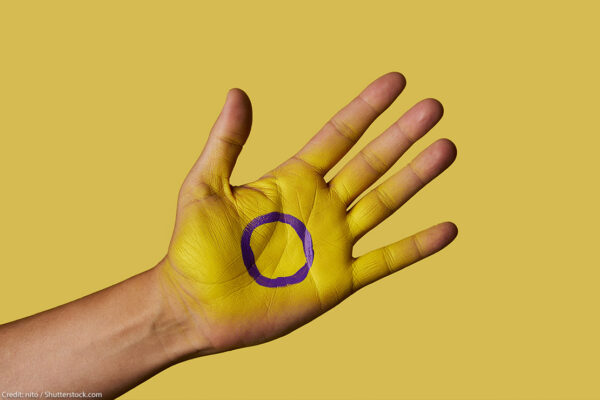Intersex people make up as much as 1.7 percent of the population and are born with bodies that differ from what others might think of as “typically” male or female. Although being intersex isn’t that rare, this population is widely misunderstood and underrepresented, much like the trans community. Racist colonial erasure, late-stage capitalism, and the medical industrial complex have combined to create implicit assumptions (and often explicit recommendations) with which trans and intersex groups are all-too familiar. We are told, usually by cis and non-intersex people, there’s only one right way to have a body — and that that body should be as normatively close to binary and cis as possible.
At interACT: Advocates for Intersex Youth, we are working hard with our partners at Patterson Belknap LLP to prepare our friend-of-the-court brief to the Ninth Circuit Court of Appeals. This follows the district court blocking an Idaho law that targeted trans student athletes and sought to exclude trans and intersex women and girls from school sports. We’re hopeful the judges of the Ninth Circuit recognize why it is so important to stop this law from going into effect.
As we prepare our brief, we also approach Intersex Awareness Day on October 26. It is particularly important on this day to recognize why intersex people continue to show up in support of the trans community and in opposition to the unrelenting efforts to deny trans people their rights. Intersex groups and the advocates who work on their behalf joined the effort to oppose HB 500 — Idaho’s law attacking transgender student athletes — not only because many intersex people are also trans (and vice versa), and not only becase the proposed approach to sex testing in sports violates the rights of the intersex community as well.
Intersex people are fighting this fight too because the community viscerally understands what’s at stake. As the complaint filed by ACLU clients Lindsay Hecox and Jane Doe explains, “Often, children discovered to be intersex in infancy are subjected to nonconsensual, harmful, and irreversible ‘normalizing’ surgical interventions, including reducing the size of the clitoris, creating a vaginal opening, and removing hormone-producing gonads in an attempt to erase their intersex differences based on notions of what is ‘normal’ for boys’ or girls’ bodies.” This is precisely the type of abuse (and it is abuse: this is deemed a form of torture by the United Nations) that flows from anti-trans bills like HB 500. There are intersex students in every school district in Idaho who in infancy survived the trauma of these surgeries, only to still be considered not “female” enough to participate on women and girls’ teams.
No one should be told by a surgeon or a coach or anyone else that their clitoris is too big to be female, or that their chromosomes are more real than their gender, or that their hormones are too “masculine” to allow them to compete as who they are.
The plaintiffs in this case are women who were fortunate enough to have medical decision-making power over their own bodies, at least in the realm of trans-related care, and who rightfully deserve to engage in college sports without anyone scrutinizing their sex characteristics. No one should be told by a surgeon or a coach or anyone else that their clitoris is too big to be female, or that their chromosomes are more real than their gender, or that their hormones are too “masculine” to allow them to compete as who they are. Trans and intersex communities have allied together because we know these are false boundaries invented to exclude already oppressed communities, usually along racist and ableist lines. Our bodies may transcend common conceptions of sex and gender, yet we exist within these systems (like sports, medicine, and institutional settings) every day and most often leave them better than when we found them.
Simplistic, bigoted approaches to trans and intersex people in these settings succeed because of intellectual and moral laziness. The refusal by the cis community to creatively imagine solutions isn’t surprising because they operate everyday within systems that prioritize cis-ness. But what’s especially egregious is when attempts are made to change the rules of the system with the specific intent of further harming groups that are already targeted in virtually all other areas, as in the case of HB 500.
The appropriate response when trans and intersex athletes try to work within an already flawed system is gracious celebration, rather than exclusion and derision. It’s telling that the resources in support of HB 500 are funneled toward litigation to appeal to the far right rather than actually building up women’s sports. These attacks are never about meaningfully protecting women.
The challenges faced by the plaintiffs in this case and those they represent are considerable already. As we celebrate Intersex Awareness Day on the 26th, let’s remember that a lack of awareness about trans and intersex lived realities — and the fact that many of us are actually joyful about our trans and intersex bodies — has allowed a cloud of shame and stigma to conceal what no lawsuit can change. Trans and intersex people are a part of the vast and diverse beauty of human existence. We will continue to improve upon tired understandings of sex and gender for as long as these systems exist.
Alesdair H. Ittelson is the Legal Director at interACT: Advocates for Intersex Youth, the nation’s largest and oldest organization working to protect the rights of people born with variations in sex characteristics.

